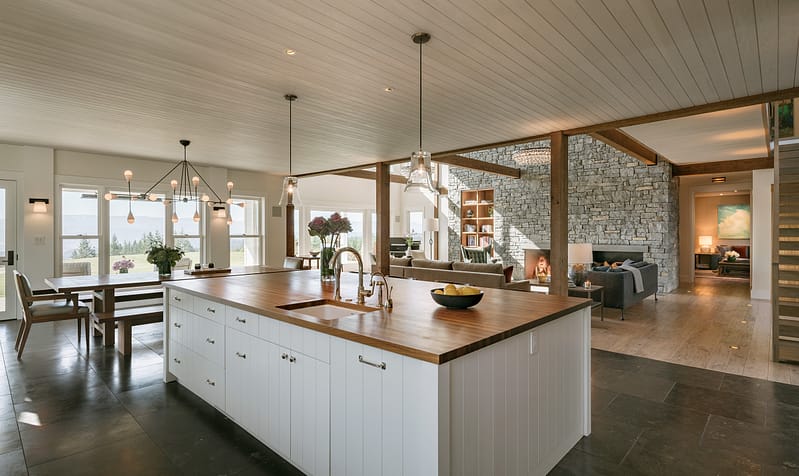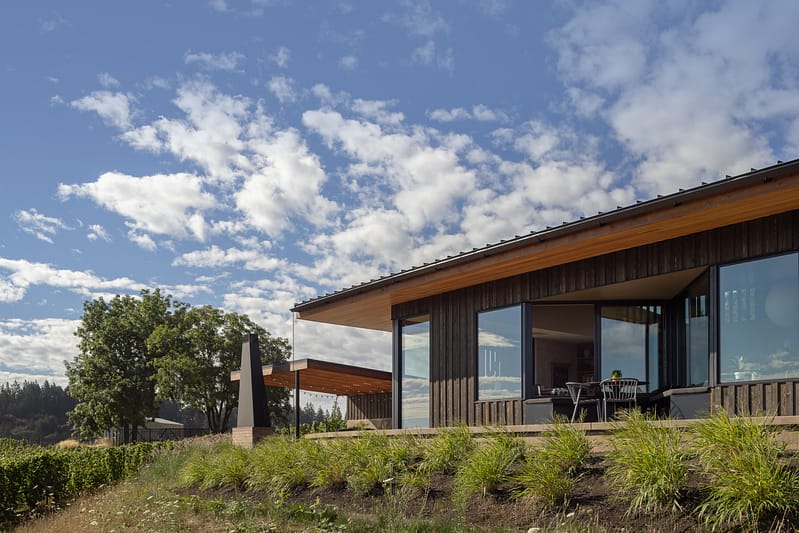
Our Tiny Bathroom Remodel has captured the imagination of Houzz visitors, Fine Homebuilding editors, and many other design aficionados, generating lots of curiosity and questions. Here are answers to the most frequently-asked:
Q: What kind of toilet is that and where can I get one?
It is a Caroma cistern toilet with an integrated hand basin. They were purchased from Caroma here.
Q: Can you share more details about the water proofing process and how to keep water from spilling outside the bathroom door into the hallway?
The Schluter Kerdi system is a preferred method for waterproofing, especially in a curbless installation. The Schluter-KERDI System is designed to work seamlessly with thinset and tile installations and has its own integrated drain systems. The waterproof membrane (shower pan) is typically run a minimum of 12″ past the opening of the shower or room. In this particular project, 18″ of the oak wood flooring at the door to the adjoining room was removed, the membrane added and the floor replaced with a wood textured tile that mimics the look of oak. The minimum required drainage for a shower floor to drain correctly is 1/4″ per ft.
This shower room is pitched immediately from the opening at a little more aggressive pitch of almost 1/2″ and a little more before the trench drain at the far wall. The toilet was set level in the room by building up a platform for it to sit on.
An integrated door sweep seals the door-to-floor gap to allow the no-lip entry to the wet room and the door itself was painted with a marine-grade paint.
Q: How do you protect the window (it looks like wood) if it’s in a shower?
We always prefer to install vinyl or fiberglass windows in showers, due to moisture concerns.
However, this project was somewhat unique, in that the homeowner wanted to keep the original wood window in place, and opted to have the window painted with several coats of oil based paint at finish.
The window trim was removed, and the tile setter installed the waterproof membrane (Kerdi system) up to the window jamb and the window trim was reinstalled using only silcone/glue, in order not to pierce the membrane with nails.
The owner is aware that maintenance is required to ensure that the unit is sealed and caulking etc. kept intact.
Q: How do we calculate the pitch of the floor to properly drain the space without overflowing into the hallway? Or maybe it is “eye-balled” since you are using a sweep under the door? But then is there an issue if a care giver is helping during bathing?
A minimum of 1/4″ drop per foot is required for drainage, but in this case we had to be a little more aggressive at 1/2″ and a little more before the trench drain at the far wall. In this project we modified the floor framing to drop that enough to accommodate the required pitch. The sweep helps, but is not a fail safe – attention is needed to not have water directed at the opening for long periods of time (the wood texture tile outside the door is key). In other words don’t spray water at the opening and you won’t have to worry about it. The only issue with including a caregiver in the space is the size – this example is really only suited to one person at a a time.
Q: How much movement (deformation) can your seals cope with? Would you build on top of the current wooden floor or strip down to the joists and rebuild?
The Schluter Kerdi system is the preferred method for waterproofing, especially in a curbless installation. The membrane is designed to work in conjunction with the drain itself so that water, which will run beneath the surface is removed as part of the system design. All caulking at corners or perpendicular surfaces will require maintenance, either due to shrinkage (drying out) or settling of the structure. This should be a yearly or as noticed effort. Sealing of grout should be reapplied every 2-3 years depending on the product used.
Q: Can you tell me how you handled heating this room? Would it be practical to put radiant floor heat under the tiles? Or what would your recommend for heating?
This room being so small and well insulated, along with being directly next to a well-heated and insulated space was not a concern. A Panasonic FV-08VKM3 – WhisperGreen 80 CFM Ventilation Fan also draws warm air into the space.
If we were to add radiant heat, a heated floor mat by Nuheat: The leading radiant electric floor heating system would be our preference and could be easily controlled with a thermostat for the space. If you wanted to utilize the existing radiator baseboard heater you could run Wirsbo piping while update the valves for that (checking with a plumber for actual needs is best).
Q: Is the ceiling tiled?
The ceiling is not tiled, it’s painted with mold-resistant primer (Zinsser Bullseye) and finished with an eggshell finish paint from Benjamin Moore.
Q: Where do you put the toilet paper and how do you keep it dry?
The toilet paper is kept on the windowsill, within reach of the toilet and out of reach of the spray from the shower head. The vent fan is on a timer that runs for a minimum of 30 minutes after a shower which also helps keep the humidity down and the paper dry.
Q: How much did this project cost?
The cost of this sort of project really depends on the specific context of your home, location of plumbing, choice of tile and fixtures, etc. But for a ballpark, the cost of a tiny bathroom like this would be similar to that of a substantial shower project, plus the sink/toilet combo and some extra time for logistics.
Read more about this bathroom remodel and check out the full portfolio of photos.




